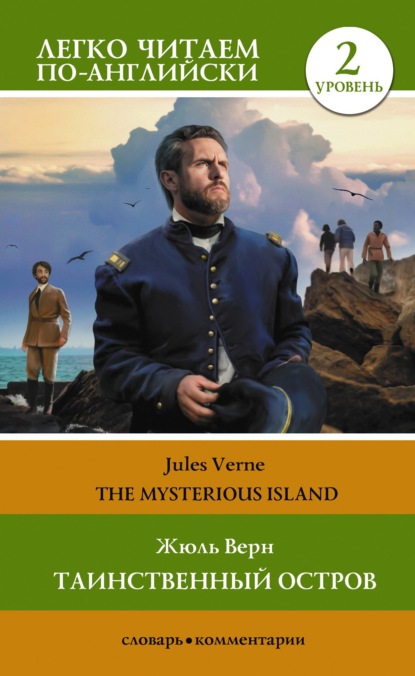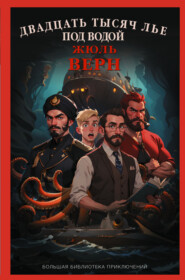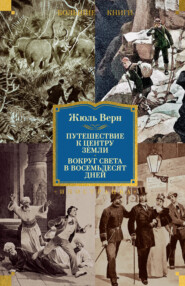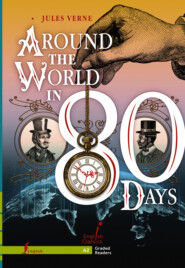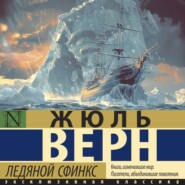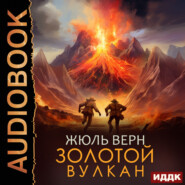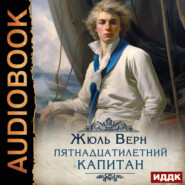По всем вопросам обращайтесь на: info@litportal.ru
(©) 2003-2024.
✖
Таинственный остров / The Mysterious Island. Уровень 2
Настройки чтения
Размер шрифта
Высота строк
Поля
The engineer was sleeping. They carried Cyrus Smith into the main corridor and made a couch of seaweeds for him.
The next day, the 28th of March, when the engineer awoke, about 8 o’clock, he saw his companions beside him. His first words were,
– Island or continent?
– Mr. Smith, – answered Pencroff, – we don’t know. But we will, when you guide us in this country.
– I think that I am able to do that now, – answered the engineer. – When you were carrying me here yesterday, did not I see a mountain in the west?
– Yes, – said Spilett, – a high mountain.
– All right, – exclaimed the engineer. – Tomorrow we will climb to its summit and determine whether this is an island or a continent.
– But, – asked Spilett, – where are we, Cyrus?
– I cannot say, – replied the engineer, – we are somewhere in the Pacific. We will know how to act when we ascend the mountain.
– But will you be able, Mr. Smith, to make the climb tomorrow? – asked Herbert.
– I hope so, – answered the engineer.
Chapter X
Soon Smith recovered his strength. They had a pleasant supper. The engineer said little; he was planning for the next day. After supper, the party lay down to sleep. In the morning they were fresh and eager for the expedition.
Everything was ready. At half past 7 they left the Chimneys, each had a stout cudgel. Pencroff recommended to take the route of the previous day, which was the shortest way to the mountain. They turned the southern angle, and followed the left bank of the river. They took the path under the evergreens, and soon reached the northern border of the forest. The soil was flat and swampy, then dry and sandy. Among the trees appeared a few animals. The engineer was going to the top of the mountain.
The mountain was composed of two cones. The first was truncated about 2,500 feet up, and supported by fantastic spurs. Between these spurs were narrow valleys.
On the first cone lay the second one. It was slightly rounded towards the summit. The goal of the expedition was to reach the top of this cone.
– We are in a volcanic country, – said Cyrus Smith, as they began to climb.
They were gradually going up. At noon, the little company stopped to dine. They were still half way from the first plateau. They could hardly reach it before nightfall. From this point the sea was beneath their feet. On the left they saw directly north for several miles; but they could not see far to the northwest.
At 1 o’clock, the ascent[21 - ascent – подъем] began again. The easiest route slanted upwards towards the southwest, through the thick copse. The climbers reached a terrace, its soil was volcanic. From hence, their course was a zigzag towards the east. Neb and Herbert led the way.
They saw large animals, with thick horns and woolly fleece. As the ascension continued, the traces of lava were more frequent. As they neared the first plateau, the ascent became very difficult. By 4 o’clock they passed the last belt of trees. It was a pleasant, mild day. The sky was bright and clear.
There were only 500 feet between the explorers and the plateau where they wanted to encamp for the night. It was almost night when the party arrived at the top of the first cone.
Now they must pitch their camp, and think of supper and sleep. The sailor built up a fireplace with huge stones. Neb and Herbert brought a load of thistles. The night was beautiful and not very dark. Cyrus decided to go further and Herbert accompanied him. Sometimes the plateau was wide and easy, sometimes very encumbered with rubbish. There were yet 1,000 feet to climb.
It was nearly 8 o’clock when they reached the summit of the cone. They hardly saw around them. Was the land an island or a continent? At one point of the horizon suddenly appeared a vague light. The line of the horizon was now cloudless, and as the moon touched it. The engineer seized the boy’s hand.
– An island! – said he.
Chapter XI
Then they walked back to the camp. The country is an island, and tomorrow they will consider what to do.
The next day, March 30, after breakfast, they started out for the summit of the volcano. All desired to see the isle. It was about 7 o’clock in the morning when they left the camp.
It was a superb day, and the southern side of the mountain was sunny. The crater was a huge shaft gradually opening to a height of 1,000 feet above the plateau. They saw on the way traces of ancient lava. At 8 o’clock, they were standing at the summit of the crater.
– The sea! the sea everywhere! – was their exclamation.
Yes, water around them on every side. Around the island stretched an ocean. They were silent and motionless. Spilett asked:
– How large is this island?
– Small enough in the midst of the infinite ocean.
– My friends, – said Smith, – I think, the coast of the island is more than 100 miles around.
If Smith was right, the island was about the size of Malta[22 - Malta – Мальта]. The eastern coast was a curve, it was embracing a large bay. On the northeast, two other capes shut in the bay. Between them lay a narrow gulf. From northeast to northwest the coast was round and flat. Then came a hump, whose centre was occupied by the volcanic mountain. From this point the coast ran directly north and south. For two-thirds[23 - two-thirds – две трети] of its length it was bordered by a narrow creek; then it finished in a long cue. The narrowest part of the island, between the Chimneys and the creek, on the west, was ten miles wide.
The southern part, from the shore to the mountain, was covered with woods. The northern part was arid and sandy. Between the volcano and the eastern coast there was a lake.
– So, it is a fresh water lake? – asked Pencroff.
– Yes, of course, – said the engineer.
– I see a little river there, – said Herbert. He pointed to a narrow brook.
The volcano did not occupy the centre of the island. It rose in the northwest.
They remained at the summit of the mountain for an hour. It was the island, but was the island inhabited? They did not perceive the handiwork of man; no settlement on the beach, no fisherman’s hut. No smoke.
The exploration of the island was finished. They drew a map of it, and calculated its size. They wanted now to examine the animal, vegetable, and mineral resources of the country. But before the departure, Cyrus Smith addressed his companions.
– Look, my friends, upon this little corner of the earth. Here, perhaps, we may long dwell.
– Mr. Smith, – said the sailor, – we will make a little America here. We will build cities, railroads, telegraphs. We will be not castaways, but colonists!
– One minute, my friends, – said the engineer; – let’s name the island, the capes, promontories, and water-courses.
– Yes, – said Smith, – for instance, let us call the great bay to the east Union Bay[24 - Union Bay – бухта Соединения], the southern indentation Washington Bay[25 - Washington Bay – бухта Вашингтона], the mountain on which we are standing Mount Franklin[26 - Mount Franklin – гора Франклина], the lake beneath our feet Lake Grant[27 - Lake Grant – озеро Гранта].
Spilett put down the names over the proper places, and the geographical nomenclature of the island was complete.
– Now, – said the reporter, – I propose to give the name of Serpentine Peninsula[28 - Serpentine Peninsula – полуостров Извилистый], and to call the twisted curve at the termination of it Reptile End[29 - Reptile End – Змеиный мыс]. It is just like a snake’s tail.
– And the other extremity of the island, – said Herbert, – the gulf is like a pair of jaws, let us call it Shark Gulf[30 - Shark Gulf – залив Акулы].
– Good, – said Pencroff, – and we may
call the two capes North Mandible[31 - North Mandible – Северная Челюсть] and South Mandible[32 - South Mandible – Южная Челюсть]. Now we must name the southwestern extremity of the island.
The next day, the 28th of March, when the engineer awoke, about 8 o’clock, he saw his companions beside him. His first words were,
– Island or continent?
– Mr. Smith, – answered Pencroff, – we don’t know. But we will, when you guide us in this country.
– I think that I am able to do that now, – answered the engineer. – When you were carrying me here yesterday, did not I see a mountain in the west?
– Yes, – said Spilett, – a high mountain.
– All right, – exclaimed the engineer. – Tomorrow we will climb to its summit and determine whether this is an island or a continent.
– But, – asked Spilett, – where are we, Cyrus?
– I cannot say, – replied the engineer, – we are somewhere in the Pacific. We will know how to act when we ascend the mountain.
– But will you be able, Mr. Smith, to make the climb tomorrow? – asked Herbert.
– I hope so, – answered the engineer.
Chapter X
Soon Smith recovered his strength. They had a pleasant supper. The engineer said little; he was planning for the next day. After supper, the party lay down to sleep. In the morning they were fresh and eager for the expedition.
Everything was ready. At half past 7 they left the Chimneys, each had a stout cudgel. Pencroff recommended to take the route of the previous day, which was the shortest way to the mountain. They turned the southern angle, and followed the left bank of the river. They took the path under the evergreens, and soon reached the northern border of the forest. The soil was flat and swampy, then dry and sandy. Among the trees appeared a few animals. The engineer was going to the top of the mountain.
The mountain was composed of two cones. The first was truncated about 2,500 feet up, and supported by fantastic spurs. Between these spurs were narrow valleys.
On the first cone lay the second one. It was slightly rounded towards the summit. The goal of the expedition was to reach the top of this cone.
– We are in a volcanic country, – said Cyrus Smith, as they began to climb.
They were gradually going up. At noon, the little company stopped to dine. They were still half way from the first plateau. They could hardly reach it before nightfall. From this point the sea was beneath their feet. On the left they saw directly north for several miles; but they could not see far to the northwest.
At 1 o’clock, the ascent[21 - ascent – подъем] began again. The easiest route slanted upwards towards the southwest, through the thick copse. The climbers reached a terrace, its soil was volcanic. From hence, their course was a zigzag towards the east. Neb and Herbert led the way.
They saw large animals, with thick horns and woolly fleece. As the ascension continued, the traces of lava were more frequent. As they neared the first plateau, the ascent became very difficult. By 4 o’clock they passed the last belt of trees. It was a pleasant, mild day. The sky was bright and clear.
There were only 500 feet between the explorers and the plateau where they wanted to encamp for the night. It was almost night when the party arrived at the top of the first cone.
Now they must pitch their camp, and think of supper and sleep. The sailor built up a fireplace with huge stones. Neb and Herbert brought a load of thistles. The night was beautiful and not very dark. Cyrus decided to go further and Herbert accompanied him. Sometimes the plateau was wide and easy, sometimes very encumbered with rubbish. There were yet 1,000 feet to climb.
It was nearly 8 o’clock when they reached the summit of the cone. They hardly saw around them. Was the land an island or a continent? At one point of the horizon suddenly appeared a vague light. The line of the horizon was now cloudless, and as the moon touched it. The engineer seized the boy’s hand.
– An island! – said he.
Chapter XI
Then they walked back to the camp. The country is an island, and tomorrow they will consider what to do.
The next day, March 30, after breakfast, they started out for the summit of the volcano. All desired to see the isle. It was about 7 o’clock in the morning when they left the camp.
It was a superb day, and the southern side of the mountain was sunny. The crater was a huge shaft gradually opening to a height of 1,000 feet above the plateau. They saw on the way traces of ancient lava. At 8 o’clock, they were standing at the summit of the crater.
– The sea! the sea everywhere! – was their exclamation.
Yes, water around them on every side. Around the island stretched an ocean. They were silent and motionless. Spilett asked:
– How large is this island?
– Small enough in the midst of the infinite ocean.
– My friends, – said Smith, – I think, the coast of the island is more than 100 miles around.
If Smith was right, the island was about the size of Malta[22 - Malta – Мальта]. The eastern coast was a curve, it was embracing a large bay. On the northeast, two other capes shut in the bay. Between them lay a narrow gulf. From northeast to northwest the coast was round and flat. Then came a hump, whose centre was occupied by the volcanic mountain. From this point the coast ran directly north and south. For two-thirds[23 - two-thirds – две трети] of its length it was bordered by a narrow creek; then it finished in a long cue. The narrowest part of the island, between the Chimneys and the creek, on the west, was ten miles wide.
The southern part, from the shore to the mountain, was covered with woods. The northern part was arid and sandy. Between the volcano and the eastern coast there was a lake.
– So, it is a fresh water lake? – asked Pencroff.
– Yes, of course, – said the engineer.
– I see a little river there, – said Herbert. He pointed to a narrow brook.
The volcano did not occupy the centre of the island. It rose in the northwest.
They remained at the summit of the mountain for an hour. It was the island, but was the island inhabited? They did not perceive the handiwork of man; no settlement on the beach, no fisherman’s hut. No smoke.
The exploration of the island was finished. They drew a map of it, and calculated its size. They wanted now to examine the animal, vegetable, and mineral resources of the country. But before the departure, Cyrus Smith addressed his companions.
– Look, my friends, upon this little corner of the earth. Here, perhaps, we may long dwell.
– Mr. Smith, – said the sailor, – we will make a little America here. We will build cities, railroads, telegraphs. We will be not castaways, but colonists!
– One minute, my friends, – said the engineer; – let’s name the island, the capes, promontories, and water-courses.
– Yes, – said Smith, – for instance, let us call the great bay to the east Union Bay[24 - Union Bay – бухта Соединения], the southern indentation Washington Bay[25 - Washington Bay – бухта Вашингтона], the mountain on which we are standing Mount Franklin[26 - Mount Franklin – гора Франклина], the lake beneath our feet Lake Grant[27 - Lake Grant – озеро Гранта].
Spilett put down the names over the proper places, and the geographical nomenclature of the island was complete.
– Now, – said the reporter, – I propose to give the name of Serpentine Peninsula[28 - Serpentine Peninsula – полуостров Извилистый], and to call the twisted curve at the termination of it Reptile End[29 - Reptile End – Змеиный мыс]. It is just like a snake’s tail.
– And the other extremity of the island, – said Herbert, – the gulf is like a pair of jaws, let us call it Shark Gulf[30 - Shark Gulf – залив Акулы].
– Good, – said Pencroff, – and we may
call the two capes North Mandible[31 - North Mandible – Северная Челюсть] and South Mandible[32 - South Mandible – Южная Челюсть]. Now we must name the southwestern extremity of the island.





